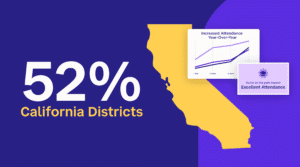
Featured Resource
Why Over Half of California School Districts Trust SchoolStatus
Read More >Join Mission: Attendance to reduce chronic absenteeism in 2025-26! >> Learn How <<





Family-teacher conferences are one of the most important opportunities for building meaningful connections with families—yet they often feel rushed, stressful, and ineffective. If you’re searching for ways to improve family-teacher conferences, you’re likely looking for practical, actionable strategies—not just theory.
In this post, we’re sharing:
For a comprehensive set of templates, planning checklists, and ready-to-use conversation guides, be sure to download The Ultimate Parent-Teacher Conference Guide.
It’s not uncommon for family-teacher conferences to feel rushed and incomplete—especially when educators are balancing large caseloads and limited on time.
The most common challenges educators report include:
Fortunately, with simple shifts in preparation and communication, educators can make conferences more productive and meaningful.
Effective family-teacher conferences start long before the meeting itself. Educators who reach out to families ahead of time often report higher attendance and more focused conversations.
What works:
Tip: Our free guide includes a pre-conference questionnaire template to help you gather input from families and set the right tone. Download it here.
Families want to know that educators see the whole child—not just academic performance. Starting every conference with specific examples of the student’s strengths and positive contributions can establish trust and set a collaborative tone.
For example, share something like:
“I’ve noticed how Maya has been encouraging her classmates during group work—she’s really emerging as a leader in class.”
When educators recognize students’ strengths, families are more receptive to discussing areas for growth.
While it’s important to share academic data, families often struggle to understand what the numbers mean or how they translate into classroom experiences.
Instead of focusing solely on scores or benchmarks, connect data to real examples of how the student is performing and how families can help.
For example:
“Right now, Lucas is reading at a level M, which is on track. We’re working on comprehension strategies like asking questions while reading. I’ll share some ways you can practice this at home.”
If you’re unsure how to have these conversations, our guide includes scripts and data-sharing strategies that make it easier.
Families should leave every conference knowing exactly what comes next.
Effective conferences end with:
Leaving with a shared action plan ensures everyone is aligned and working together to support the student.
Our free guide includes conference summary and next-step templates to help with this process. Get the guide.
The most effective family-teacher conferences are part of an ongoing conversation—not just a one-time meeting. Establishing regular, proactive communication with families helps prevent surprises and build trust.
Consider setting up:
If you’re looking for a system to manage ongoing family communication, SchoolStatus Connect is designed to simplify this process for educators and administrators.
If you’re looking for a structured, ready-to-use set of resources to guide every step of the family-teacher conference process, The Ultimate Parent-Teacher Conference Guide can help.
Inside you’ll find:
Download the free guide now to ensure your next family-teacher conference is productive, focused, and collaborative.
Family-teacher conferences are an essential part of supporting student success. With the right preparation, tools, and communication strategies, educators can turn these meetings into meaningful opportunities to build strong partnerships with families.
Whether you’re preparing for a single conference or planning school-wide improvements to family engagement, having a clear strategy makes a measurable difference—and our guide is designed to help you get there.
 SchoolStatusSchoolStatus gives educators the clarity and tools they need to get students to class and keep them moving ahead. Through our integrated suite of data-driven products, we help districts spot attendance patterns early, reach families in ways that work for them, and support teacher growth with meaningful feedback. Our solutions include automated attendance interventions, multi-channel family communications in 130+ languages, educator development and coaching, streamlined digital workflows, and engaging school websites. Serving over 22 million students across thousands of districts in all 50 states, SchoolStatus helps teachers and staff see what matters, act with speed, and stay focused on students.
SchoolStatusSchoolStatus gives educators the clarity and tools they need to get students to class and keep them moving ahead. Through our integrated suite of data-driven products, we help districts spot attendance patterns early, reach families in ways that work for them, and support teacher growth with meaningful feedback. Our solutions include automated attendance interventions, multi-channel family communications in 130+ languages, educator development and coaching, streamlined digital workflows, and engaging school websites. Serving over 22 million students across thousands of districts in all 50 states, SchoolStatus helps teachers and staff see what matters, act with speed, and stay focused on students.
News, articles, and tips for meeting your district’s goals—delivered to your inbox.



Ready to learn more about our suite of solutions?
